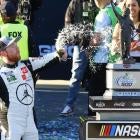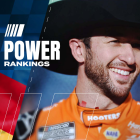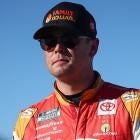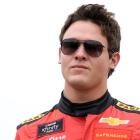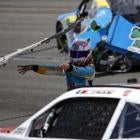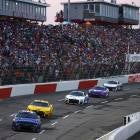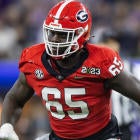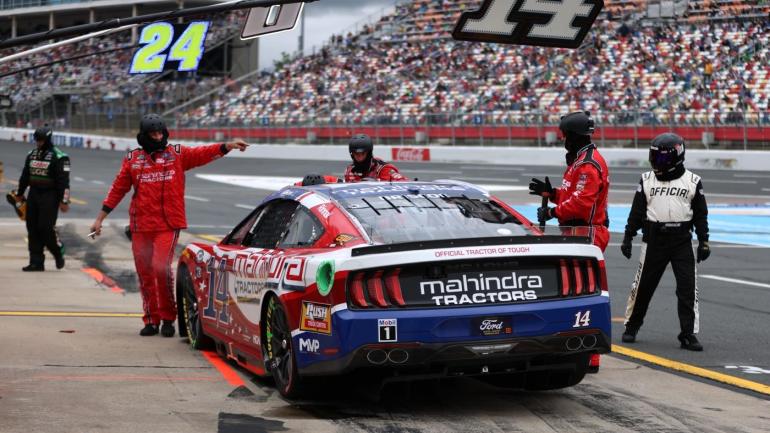
NASCAR announced Wednesday that the No. 14 Stewart-Haas Racing team has received an L3-level penalty after the team was discovered to be using counterfeit parts. The discovery was made after the No. 14 driven by Chase Briscoe was brought back for inspection at NASCAR's Research & Development Center following the Coca-Cola 600 on Monday.
According to NASCAR senior vice president of competition Elton Sawyer, inspectors found an engine panel NACA duct in Briscoe's car that was not in compliance with the sport's rule book. The No. 14 team was ultimately found to be in violation of multiple sections of the rule book, including Section 14.1C&F (overall assembled vehicle rules), 14.6.A (underwing) and 14.6.3.B (underwing).
As a result, NASCAR has penalized Chase Briscoe 125 driver points and the No. 14 team 125 owner points, while also docking the team 25 playoff points. Crew chief John Klausmeier has been suspended for the next six Cup Series races and fined $250,000.
What it means for NASCAR
Stewart-Haas Racing now becomes the first team to receive an L3-level penalty, the most severe in the three-tiered penalty system introduced by the sanctioning body in 2022. L3-level penalties are reserved for counterfeiting Next Gen car parts as well as other severe offenses like engine infractions and performance enhancements (nitrous oxide, vacuum leaks, etc.), modifying tires and/or fuel, and violations of private team testing policy.
The scale of the penalty is not only the most severe since the introduction of the Next Gen car in 2022 -- even including a historically large L2-level penalty given to Hendrick Motorsports earlier this year -- but it is also on par with some of the largest penalties ever assessed by NASCAR for technical violations.
- In 1983, Richard Petty was penalized 104 points and fined $35,000 after his team was found to have used an engine that was well above the limit of 358-cubic inches to win at Charlotte in the fall of that year. The Petty Enterprises was also found to have deliberately put left-side tires on the right side of Petty's car in order to gain a performance advantage.
- In the 1995 Coca-Cola 600, Jeff Gordon's car was found to be using suspension parts that did not meet NASCAR specifications after Gordon dropped out with suspension failure after 283 laps. As a result, crew chief Ray Evernham was given a then-record $60,000 fine.
- In 2000, Team Penske was caught using oxygenate as a performance-enhancing fuel additive in Jeremy Mayfield's car that won the pole for the spring race at Talladega Superspeedway. The team was docked 151 points and fined $50,000, with crew chief Pete Sospenzo earning a two-month suspension.
- In 2007, Michael Waltrip Racing was caught using an illegal additive used in jet fuel inside the intake manifold of Michael Waltrip's car prior to Daytona 500 qualifying. Waltrip's team was fined $100,000 and docked 100 points, with crew chief David Hyder and competition director Bobby Kennedy both getting suspended indefinitely.
- In 2009, NASCAR officials determined that the engine being used by owner/driver Carl Long for All-Star Race weekend was 1/6th of an inch too large. Long was suspended for the next 12 weeks, and his team was fined $200,000 and penalized 200 points. The penalty crippled Long's team to the point that it did not attempt another Cup race until 2017.
With NASCAR's move to single-source supplied parts for the Next Gen car, NASCAR has handed out severe penalties to teams in an effort to change the sport's long-established culture around modifying parts and pieces in order to gain an advantage. In this case, NASCAR.com's story noted that tightening or counterfeiting/modifying the NACA ducts that run from the engine panel can help a team illegally create more downforce.
"We need to make sure we're keeping the teams and the car in compliance. The deterrence model has to fit that, and that's our responsibility as custodians of the sport and of the garage," Sawyer told NASCAR.com. "Don't mess with a single-source part. Working in areas we used to in the Gen-6 car, is just not going to be acceptable with this car as we move forward. It's not going to be the culture we're going to allow."
What it means for Briscoe and SHR
The penalty dramatically alters Briscoe's 2023 season, as it effectively kneecaps any realistic chances he has of making the playoffs without winning a race. Briscoe had been 17th in the Cup Series standings prior to the penalty, only four points behind Alex Bowman for the final spot on the playoff grid. Now, Briscoe is 31st in the Cup standings with only 172 points, the third-least of all drivers who have attempted every race this season.
Briscoe has not had a great season as a whole, with an average finish of just 18.1 despite three top five and four top 10 finishes. Briscoe, who finished ninth in the Cup Series standings and earned his first career win last season, is just one party afflicted by the struggles of Stewart-Haas Racing, which has underperformed outside of Kevin Harvick's No. 4 team.
In a statement, the team blamed a "quality control lapse" for the counterfeit part that ended up on Briscoe's car, which only managed a 20th-place finish in the Coke 600 at Charlotte. The team will not appeal, and Mike Bugarewicz will reportedly take over as Briscoe's crew chief for the next six weeks.














